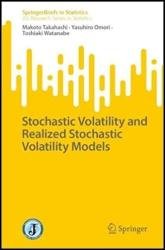Stochastic Volatility and Realized Stochastic Volatility Models
- Добавил: literator
- Дата: 19-04-2023, 17:00
- Комментариев: 0
 Название: Stochastic Volatility and Realized Stochastic Volatility Models
Название: Stochastic Volatility and Realized Stochastic Volatility ModelsАвтор: Makoto Takahashi, Yasuhiro Omori, Toshiaki Watanabe ·
Издательство: Springer
Серия: SpringerBriefs in Statistics
Год: 2023
Страниц: 120
Язык: английский
Формат: pdf (true), epub
Размер: 20.8 MB
This treatise delves into the latest advancements in stochastic volatility models, highlighting the utilization of Markov chain Monte Carlo simulations for estimating model parameters and forecasting the volatility and quantiles of financial asset returns. The modeling of financial time series volatility constitutes a crucial aspect of finance, as it plays a vital role in predicting return distributions and managing risks. Among the various econometric models available, the stochastic volatility model has been a popular choice, particularly in comparison to other models, such as GARCH models, as it has demonstrated superior performance in previous empirical studies in terms of fit, forecasting volatility, and evaluating tail risk measures such as Value-at-Risk and Expected Shortfall.
The book also explores an extension of the basic stochastic volatility model, incorporating a skewed return error distribution and a realized volatility measurement equation. The concept of realized volatility, a newly established estimator of volatility using intraday returns data, is introduced, and a comprehensive description of the resulting realized stochastic volatility model is provided. The text contains a thorough explanation of several efficient sampling algorithms for latent log volatilities, as well as an illustration of parameter estimation and volatility prediction through empirical studies utilizing various asset return data, including the yen/US dollar exchange rate, the Dow Jones Industrial Average, and the Nikkei 225 stock index.
The aim of this book is to introduce recent developments in stochastic volatility models for asset returns such as returns of stocks, foreign currencies, and interest rates. It is intended for researchers who are interested in Bayesian analysis of financial time series. In financial markets, it is well known that financial time series often exhibit a behavior called volatility clustering and that the volatility of the asset return changes randomly with high persistence. The stochastic volatility model describes such dynamic structures of the unobserved volatilities. We first introduce the basic stochastic volatility model and then extend it to various volatility models. Noting that realized volatility computed from high-frequency data has recently been used to estimate true volatility, we also discuss joint modeling of the asset return and realized volatility, which is called realized stochastic volatility.
Chapter 1 summarizes the topics covered in this book. We describe the various stochastic volatility models covered in this book including the basic model, the asymmetric stochastic volatility model, the stochastic volatility model with generalized hyperbolic (GH) skewed Student’s t error, and joint modeling of stochastic volatility and realized volatility.
Chapter 2 discusses the basic stochastic volatility model and describes an estimation method using Markov chain Monte Carlo (MCMC) simulation. In stochastic volatility models, there are as many latent volatilities as asset returns, and we need to integrate them out to compute the likelihood function. Since it is difficult to obtain the likelihood numerically, we use the Bayesian approach and implement MCMC simulation to facilitate statistical inference of model parameters. The simple MCMC sampling algorithm for the latent log volatilities is called a single-move sampler, which samples one variable given other variables. However, it is known to be inefficient in the sense that it produces highly autocorrelated MCMC samples. To overcome this difficulty, we describe two major efficient MCMC estimation methods: the mixture sampler and the multi-move (or block) sampler. The former transforms the model into a linear state-space model and approximates the error distribution using a mixture of normal distributions. Given the mixture normal distribution, the volatilities are generated all at once. The latter method generates a block of state variables given other parameters and latent variables. Using real data in empirical studies, we will show that they are highly efficient.
Chapter 3 introduces the asymmetric stochastic volatility model, which extends the basic model to allow for correlation between the return and log volatility errors. It has long been recognized in stock markets that a decrease in today’s return is followed by an increase in the tomorrow’s volatility. This phenomenon is called the “leverage effect” or “asymmetry.” The efficient MCMC algorithms given in Chap. 2 are extended to incorporate such a negative correlation between the errors for the leverage effect.
This publication is highly recommended for readers with an interest in the latest developments in stochastic volatility models and realized stochastic volatility models, particularly in regards to financial risk management.
Contents:
Скачать Stochastic Volatility and Realized Stochastic Volatility Models
[related-news] [/related-news]
Внимание
Уважаемый посетитель, Вы зашли на сайт как незарегистрированный пользователь.
Мы рекомендуем Вам зарегистрироваться либо войти на сайт под своим именем.
Уважаемый посетитель, Вы зашли на сайт как незарегистрированный пользователь.
Мы рекомендуем Вам зарегистрироваться либо войти на сайт под своим именем.

